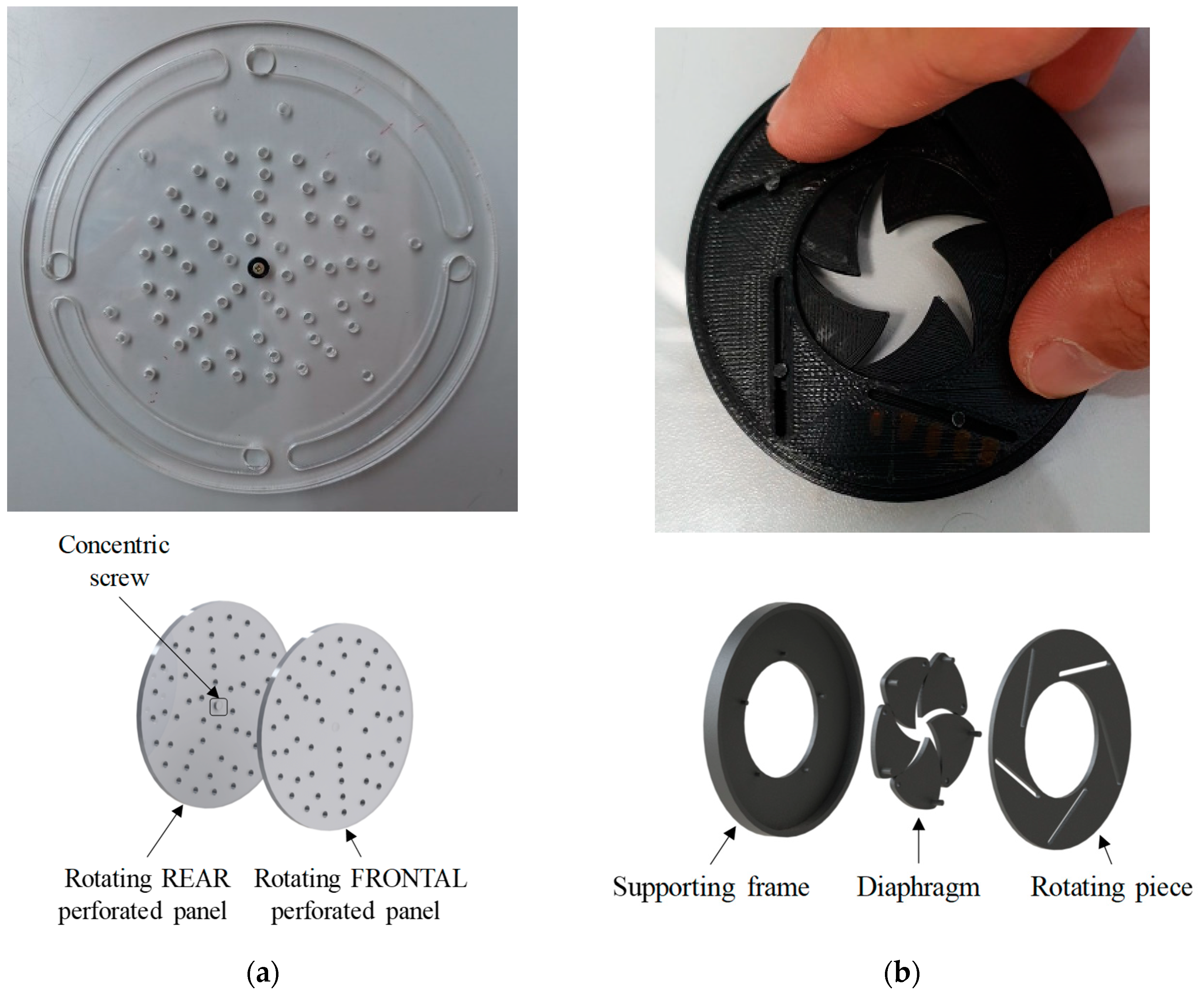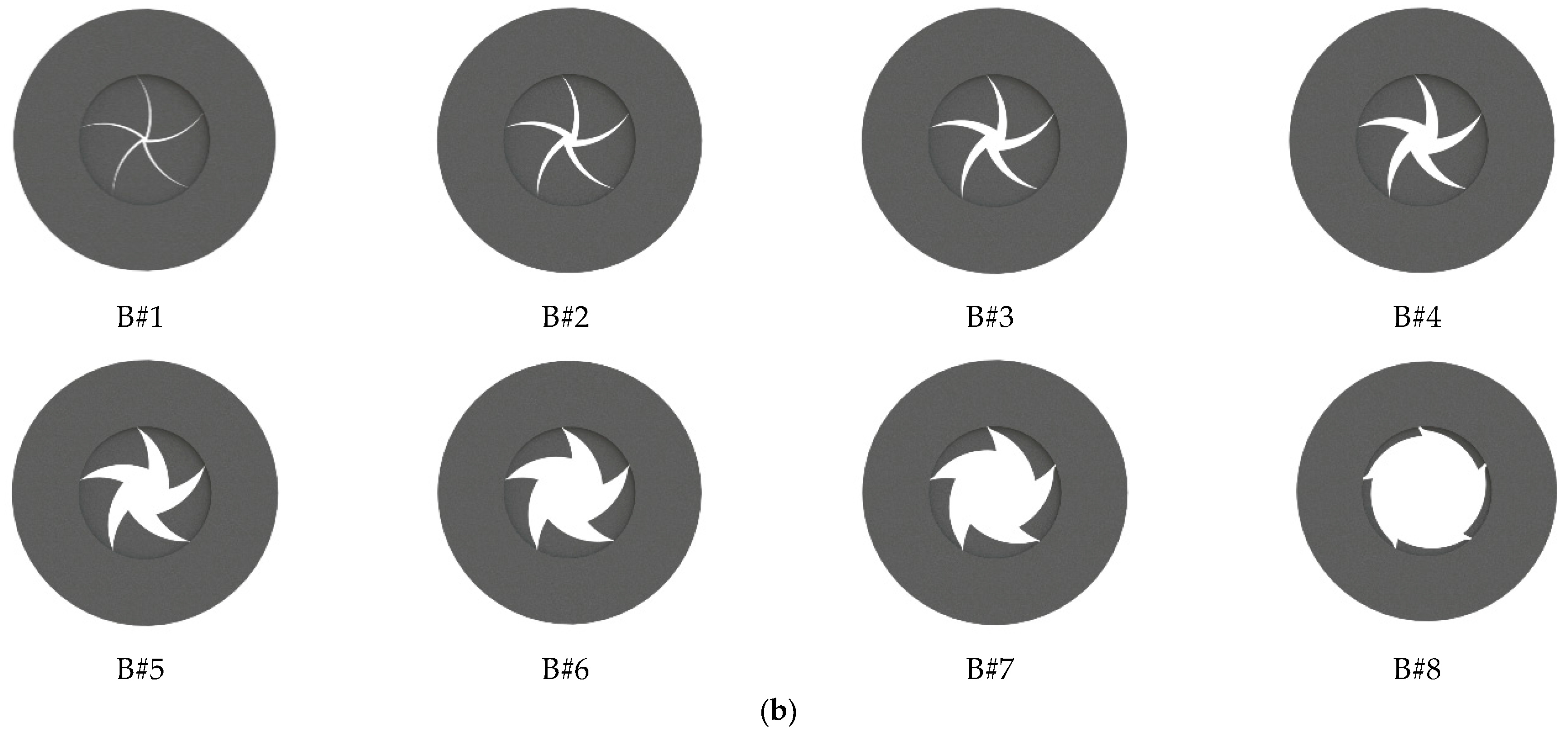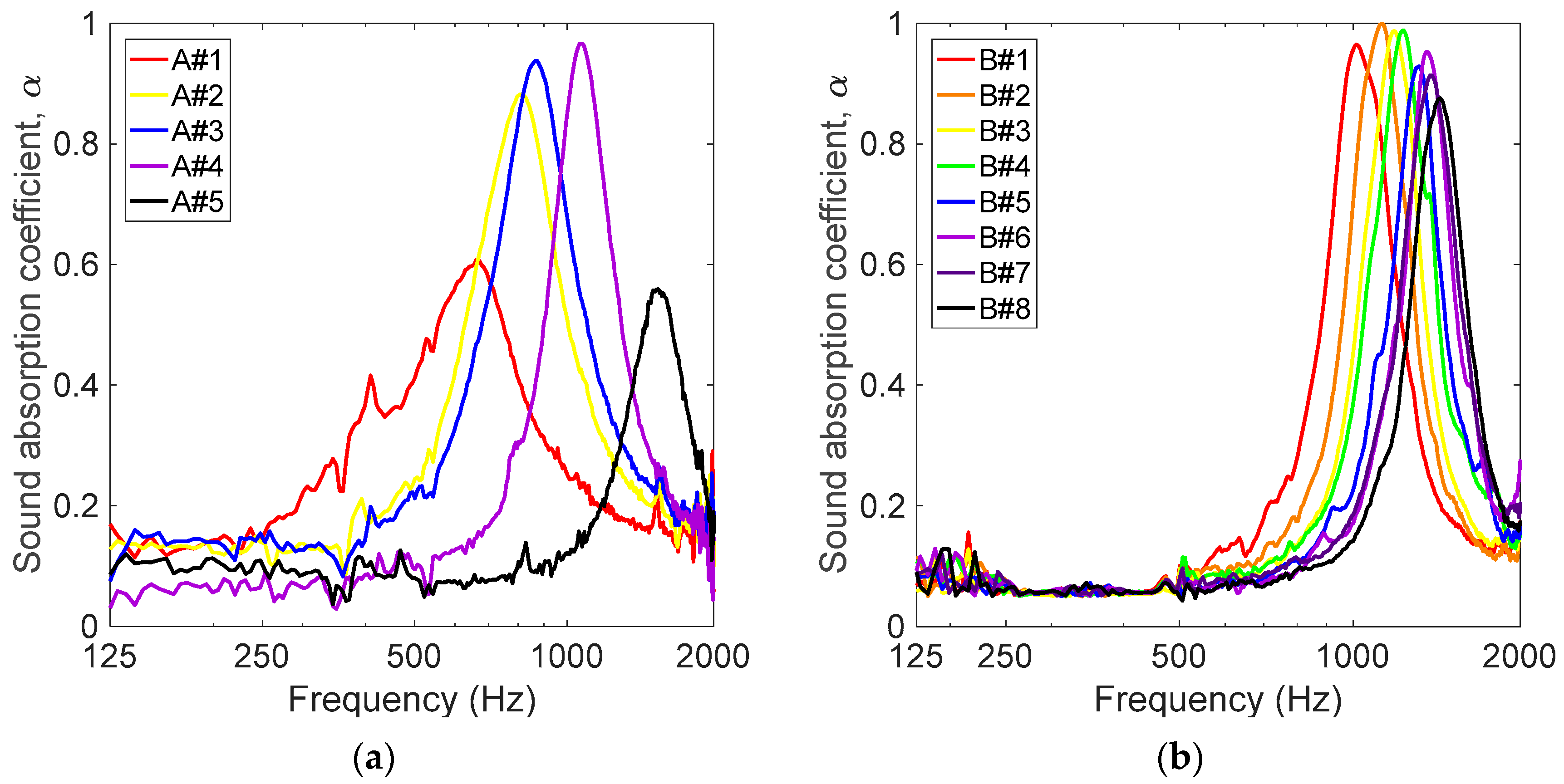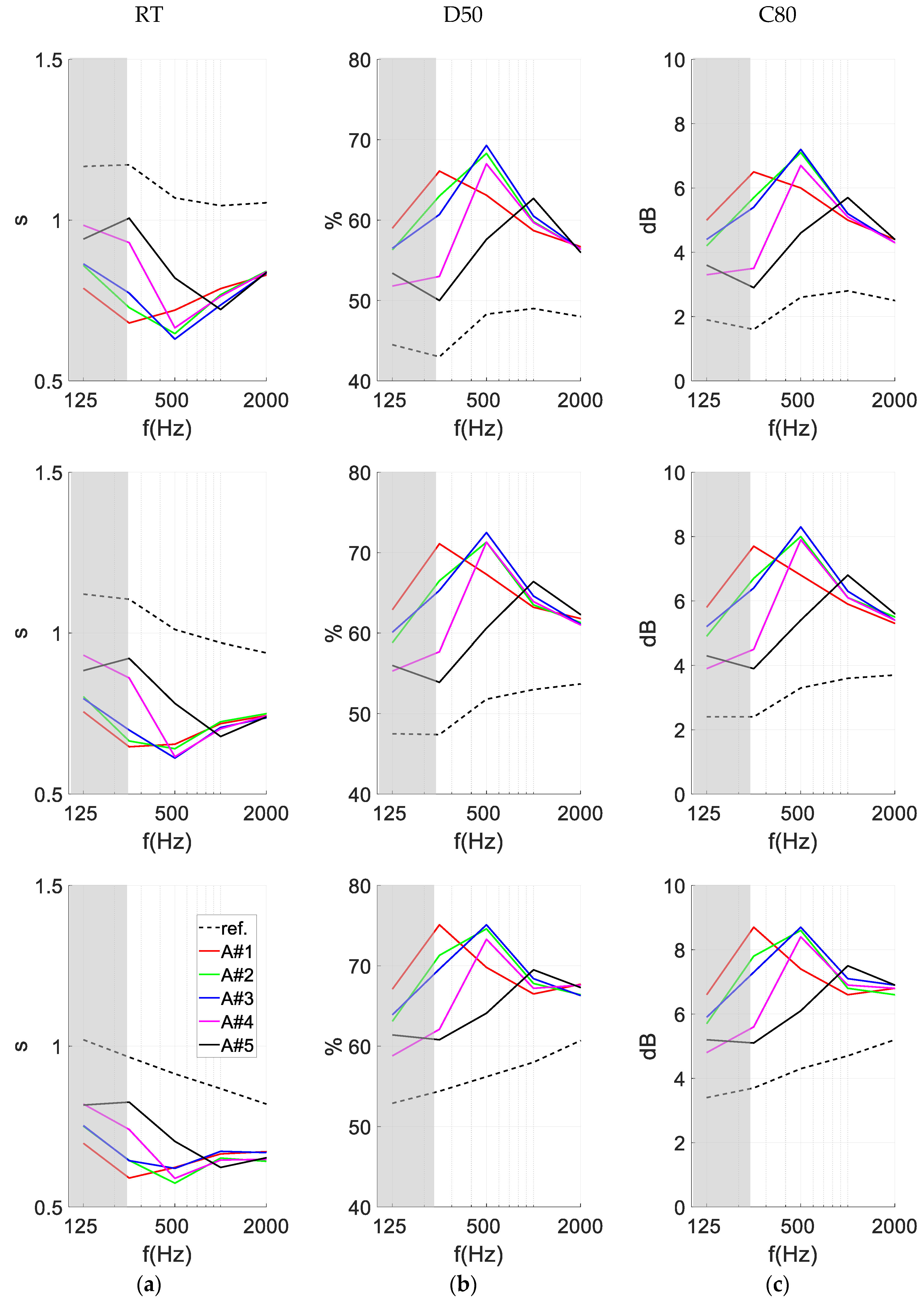Tunable Perforated Panel Sound Absorbers for Variable Acoustics Room Design
Abstract
:1. Introduction
2. Materials
2.1. Perforated Panel Sound Absorber
2.2. Tunable Solution A (TS-A): Rotating Perforated Panels
2.3. Tunable Solution B (TS-B): Iris-Type Aperture

| Solution | Panel Thickness (mm) | Perforation Radius (mm) | Open Area Ratio (%) |
|---|---|---|---|
| TS-A | 4 | 1.5 | 0.6–5.6 |
| TS-B | 2 | - | 0.7–14.1 |
3. Methods
3.1. Impedance Tube Setup
3.2. Ray Tracing Method
4. Results and Discussion
4.1. Parametric Study of the Different Solutions in Terms of Sound Absorption
4.2. Case Study: Application to Variable Acoustics Room Design
4.3. Remarks on the In Situ Implementation
5. Conclusions
Author Contributions
Funding
Institutional Review Board Statement
Informed Consent Statement
Data Availability Statement
Conflicts of Interest
References
- Beranek, L. Concert Halls and Opera Houses: Music, Acoustics, and Architecture; Springer: New York, NY, USA, 2004. [Google Scholar]
- Cox, T.; d’Antonio, P. Acoustics Absorbers and Diffusers: Theory, Design and Application; Taylor & Francis: Abingdon, UK, 2009. [Google Scholar]
- Allard, J.F.; Atalla, N. Propagation of sound in porous media. In Modelling Sound Absorbing Materials; John Wiley and Sons: Chichester, UK, 2009. [Google Scholar]
- Maa, D.Y. Theory and design of microperforated-panel sound-absorbing construction. Sci. Sin. 1975, 18, 55–71. [Google Scholar]
- Fuchs, H.V.; Zha, X. Micro-perforated structures as sound absorbers—A review and outlook. Acta Acust. United Acust. 2006, 92, 139–146. [Google Scholar]
- Barron, M. Acoustic for multi-purpose use. In Auditorium Acoustics and Architectural Design; Spon Press: London, UK, 2010. [Google Scholar]
- Cairoli, M. Architectural customized design for variable acoustics in multipurpose auditorium. Appl. Acoust. 2018, 140, 167–177. [Google Scholar] [CrossRef]
- Poletti, M.A. Active acoustic systems for the control of room acoustics. Build. Acoust. 2011, 18, 237–258. [Google Scholar] [CrossRef]
- Everest, F.A.; Pohlmann, K.C. Chapter 15: Adjustable Acoustics. In Master Handbook of Acoustics; McGraw-Hill: New York, NY, USA, 2009. [Google Scholar]
- Ma, G.; Fan, X.; Sheng, P.; Fink, M. Shaping reverberating sound fields with an actively tunable metasurface. Proc. Natl. Acad. Sci. USA 2018, 115, 6638–6643. [Google Scholar] [CrossRef]
- Xie, S.-H.; Fang, X.; Li, P.-Q.; Huang, S.; Peng, Y.-G.; Shen, Y.-X.; Li, Y.; Zhu, X.-F. Tunable double-band perfect absorbers via acoustic metasurfaces with nesting helical tracks. Chin. Phys. Lett. 2020, 37, 054301. [Google Scholar] [CrossRef]
- Liu, H.; Wu, J.H.; Ma, F. Dynamic tunable acoustic metasurface with continuously perfect sound absorption. J. Phys. D Appl. Phys. 2021, 54, 365105. [Google Scholar] [CrossRef]
- Xiang, X.; Tian, H.; Huang, Y.; Wu, X.; Wen, W. Manually tunable ventilated metamaterial absorbers. Appl. Phys. Lett. 2021, 118, 053504. [Google Scholar] [CrossRef]
- Hildebrand, M. Development of tunable absorber/diffuser using micro-perforated panels. J. Acoust. Soc. Am. 2014, 136, 2115–2116. [Google Scholar] [CrossRef]
- Jiang, P.; Jian, T.; He, Q. Origami-based adjustable sound-absorbing metamaterial. Smart Mater. Struct. 2021, 30, 057002. [Google Scholar] [CrossRef]
- Cobo, P.; Pfretzschner, J.; Cuesta, M.; Anthony, D.K. Hybrid passive-active absorption using microperforated panels. J. Acoust. Soc. Am. 2004, 116, 2118–2125. [Google Scholar] [CrossRef]
- Lu, Z.; Shrestha, M.; Lau, G.-K. Electrically tunable and broader-band sound absorption by using micro-perforated dielectric elastomer actuator. Appl. Phys. Lett. 2017, 110, 182901. [Google Scholar] [CrossRef]
- Kong, D.Y.; Xie, D.Y.; Tang, X.N.; Hu, M.; Xu, H.; Qian, Y.J. Experimental study of a compact piezoelectric micro-perforated panel absorber with adjustable acoustic property. J. Acoust. Soc. Am. 2020, 147, EL2083. [Google Scholar] [CrossRef]
- ISO 10534-2; Determination of Sound Absorption Coefficient and Impedance in Impedance Tubes. International Organization for Standardization: Geneva, Switzerland, 2023.
- Zieliński, T.G.; Dauchez, N.; Boutin, T.; Leturia, M.; Wilkinson, A.; Chevillotte, F.; Bécot, F.-X.; Venegas, R. Taking advantage of a 3D printing imperfection in the development of sound absorbing materials. Appl. Acoust. 2022, 197, 108941. [Google Scholar] [CrossRef]
- Okuzono, T.; Sakagami, K. A frequency domain finite element solver for acoustic simulation of 3D rooms with microperforated panel absorbers. Appl. Acoust. 2018, 129, 1–12. [Google Scholar] [CrossRef]
- Hoshi, K.; Hanyu, T.; Okuzono, T.; Sakagami, K.; Yairi, M.; Harada, S.; Takahashi, S.; Ueda, Y. Implementation experiment of a honeycomb-backedd MPP sound absorber in a meeting room. Appl. Acoust. 2020, 157, 107000. [Google Scholar] [CrossRef]
- Toyoda, M.; Eto, D. Prediction of microperforated panel absorbers using the finite-difference time-domain method. Wave Motion 2019, 86, 110–124. [Google Scholar] [CrossRef]
- Cingolani, M.; Fratoni, G.; Barbaresi, L.; D’Orazio, D.; Hamilton, B.; Garai, M. A trial acoustic improvement in a lecture hall with MPP sound absorbers and FDTD acoustic simulations. Appl. Sci. 2021, 11, 2445. [Google Scholar] [CrossRef]
- Pereira, A.; Gaspar, A.; Godinho, L.; Amado-Mendes, P.; Mateus, D.; Carbajo, J.; Ramis, J.; Poveda, P. On the use of Perforated sound absorption systems for variable acoustics room design. Buildings 2021, 11, 543. [Google Scholar] [CrossRef]
- Vorländer, M. Auralization: Fundamentals of Acoustics, Modelling, Simulation, Algorithms and Acoustic Virtual Reality; Springer: Berlin/Heidelberg, Germany, 2008. [Google Scholar]
- Ciochon, A.; Kennedy, J.; Leiba, R.; Flanagan, L.; Culleton, M. The impact of surface roughness on an additively manufactured acoustic material: An experimental and numerical investigation. J. Sound. Vib. 2023, 546, 117434. [Google Scholar] [CrossRef]
- Fusaro, G.; Babaresi, L.; Cingolani, M.; Garai, M.; Ida, E.; Prato, A.; Schiavi, A. Investigation of the impact of additive manufacturing techniques on the acoustic performance of a coiled-up resonator. J. Acoust. Soc. Am. 2023, 153, 2921. [Google Scholar] [CrossRef] [PubMed]
- Soares, M.C.; Carneiro, E.B.; Tenenbaum, R.A.; Mareze, P.H. Low-frequency room acoustical simulation of a small room with BEM and complex-valued surface impedances. Appl. Acoust. 2022, 188, 108570. [Google Scholar] [CrossRef]
- Iannace, G.; Sicurella, F.; Colamesta, P.; Gentilin, M. Acoustic project of a conference room of the secondary school “Avenir 33” (Delémont, Switzerland). Can. Acoust. 2018, 46, 31–38. [Google Scholar]
- Bhardwaj, H.; Tomar, P.; Skalle, A.; Sharma, U. Chapter 20. Principles and Foundations of Artificial Intelligence and Internet of Things Technology. In Artificial Intelligence to Solve Pervasive Internet of Things Issues; Academic Press: Cambridge, MA, USA, 2021. [Google Scholar]
- Hondaveeti, H.K.; Mathe, S.E. A Systematic Literature Review on Prototyping with Arduino: Applications, Challenges, Advantages, and Limitations. Comput. Sci. Rev. 2021, 40, 100364. [Google Scholar] [CrossRef]
- Dragonetti, R.; Ianniello, C.; Romano, R. Preliminary acoustic measurements in the Oscar Niemeyer auditorium in Ravello. In Proceedings of the 39th International Congress on Noise Control Engineering 2010, INTER-NOISE 2010, Lisbon, Portugal, 13–16 June 2010. [Google Scholar]
- Sadehnia, G.R. Data-driven IoT-platform for optimizing variable acoustics in multifunctional performance spaces. J. Acoust. Soc. Am. 2019, 146, 2851. [Google Scholar] [CrossRef]
- Sakagami, K.; Kusaka, M.; Okuzono, T.; Kido, S.; Yamaguchi, D. Three-dimensional MPP space absorbers: An overview of the project and recent development. Proc. Inter-Noise 2020, 261, 358–368. [Google Scholar]
- Lee, H.P.; Kumar, S.; Aow, J.W. Proof-of-concept design for MPP acoustic absorbers with elements of art. Designs 2021, 5, 72. [Google Scholar] [CrossRef]
- Ciaburro, G.; Iannace, G.; Puyana-Romero, V.; Trematerra, A. A comparison between numerical simulation models for the prediction of acoustic behavior of shredded giant reeds. Appl. Sci. 2020, 10, 6881. [Google Scholar] [CrossRef]
- Ciaburro, G.; Iannace, G. Numerical simulation for the sound absorption properties of ceramic resonators. Fibers 2020, 8, 77. [Google Scholar] [CrossRef]





| Frequency | |||||||
|---|---|---|---|---|---|---|---|
| Standard Solution | 125 Hz | 250 Hz | 500 Hz | 1 kHz | 2 kHz | 4 kHz | 8 kHz |
| Occupied seat (m2 per unit) | 0.18 | 0.24 | 0.28 | 0.33 | 0.37 | 0.39 | 0.42 |
| Unoccupied seat (m2 per unit) | 0.02 | 0.02 | 0.03 | 0.04 | 0.06 | 0.08 | 0.08 |
| Floor in wood parquet on concrete (α) | 0.04 | 0.04 | 0.07 | 0.06 | 0.06 | 0.07 | 0.07 |
| Plastered masonry wall (α) | 0.01 | 0.02 | 0.02 | 0.03 | 0.04 | 0.05 | 0.05 |
| Suspended ceiling (α) | 0.29 | 0.25 | 0.25 | 0.23 | 0.19 | 0.19 | 0.18 |
| Variable Solution | Open Area Ratio (%) | |||||||
|---|---|---|---|---|---|---|---|---|
| TS-A | A#1 | A#2 | A#3 | A#4 | A#5 | |||
| 0.6 | 1.2 | 1.4 | 2.7 | 5.6 | ||||
| TS-B | B#1 | B#2 | B#3 | B#4 | B#5 | B#6 | B#7 | B#8 |
| 0.7 | 1.7 | 2.7 | 3.9 | 6.1 | 8.7 | 10.6 | 14.1 | |
| Frequency (Hz) | |||||
|---|---|---|---|---|---|
| TS-A Variable Solution | 125 | 250 | 500 | 1 k | 2 k |
| A#1 | 0.18 | 0.30 | 0.62 | 0.39 | 0.25 |
| A#2 | 0.23 | 0.22 | 0.46 | 0.59 | 0.27 |
| A#3 | 0.26 | 0.23 | 0.39 | 0.64 | 0.30 |
| A#4 | 0.07 | 0.11 | 0.17 | 0.56 | 0.28 |
| A#5 | 0.16 | 0.16 | 0.13 | 0.21 | 0.35 |
Disclaimer/Publisher’s Note: The statements, opinions and data contained in all publications are solely those of the individual author(s) and contributor(s) and not of MDPI and/or the editor(s). MDPI and/or the editor(s) disclaim responsibility for any injury to people or property resulting from any ideas, methods, instructions or products referred to in the content. |
© 2024 by the authors. Licensee MDPI, Basel, Switzerland. This article is an open access article distributed under the terms and conditions of the Creative Commons Attribution (CC BY) license (https://creativecommons.org/licenses/by/4.0/).
Share and Cite
Carbajo, J.; Poveda-Martínez, P.; Godinho, L.; Pereira, A.; Gaspar, A.; Amado-Mendes, P.; Mateus, D.; Ramis, J. Tunable Perforated Panel Sound Absorbers for Variable Acoustics Room Design. Appl. Sci. 2024, 14, 2094. https://doi.org/10.3390/app14052094
Carbajo J, Poveda-Martínez P, Godinho L, Pereira A, Gaspar A, Amado-Mendes P, Mateus D, Ramis J. Tunable Perforated Panel Sound Absorbers for Variable Acoustics Room Design. Applied Sciences. 2024; 14(5):2094. https://doi.org/10.3390/app14052094
Chicago/Turabian StyleCarbajo, Jesús, Pedro Poveda-Martínez, Luís Godinho, Andreia Pereira, Anna Gaspar, Paulo Amado-Mendes, Diogo Mateus, and Jaime Ramis. 2024. "Tunable Perforated Panel Sound Absorbers for Variable Acoustics Room Design" Applied Sciences 14, no. 5: 2094. https://doi.org/10.3390/app14052094







